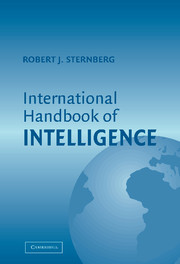Book contents
- Frontmatter
- Contents
- List of Contributors
- Preface
- 1 Intelligence Research and Assessment in the United Kingdom
- 2 Intelligence – Theory, Research, and Testing in the Nordic Countries
- 3 The Psychology of Human Intelligence in Spain
- 4 Psychology of Human Intelligence in France and French-Speaking Switzerland
- 5 Research on Intelligence in German-Speaking Countries
- 6 Is It Possible to Study Intelligence Without Using the Concept of Intelligence? An Example from Soviet/Russian Psychology
- 7 Intelligence Theory, Assessment, and Research: The Israeli Experience
- 8 Intelligence and Intelligence Testing in Turkey
- 9 Intelligence: What Is Indigenous to India and What Is Shared?
- 10 Japanese Conception of and Research on Human Intelligence
- 11 Diligence Makes People Smart: Chinese Perspectives of Intelligence
- 12 Similar Thoughts under Different Stars: Conceptions of Intelligence in Australia
- 13 Being Intelligent with Zimbabweans: A Historical and Contemporary View
- 14 Intelligence Research in Latin America
- 15 North American Approaches to Intelligence
- 16 Human Intelligence: From Local Models to Universal Theory
- Index
- References
7 - Intelligence Theory, Assessment, and Research: The Israeli Experience
Published online by Cambridge University Press: 05 June 2012
- Frontmatter
- Contents
- List of Contributors
- Preface
- 1 Intelligence Research and Assessment in the United Kingdom
- 2 Intelligence – Theory, Research, and Testing in the Nordic Countries
- 3 The Psychology of Human Intelligence in Spain
- 4 Psychology of Human Intelligence in France and French-Speaking Switzerland
- 5 Research on Intelligence in German-Speaking Countries
- 6 Is It Possible to Study Intelligence Without Using the Concept of Intelligence? An Example from Soviet/Russian Psychology
- 7 Intelligence Theory, Assessment, and Research: The Israeli Experience
- 8 Intelligence and Intelligence Testing in Turkey
- 9 Intelligence: What Is Indigenous to India and What Is Shared?
- 10 Japanese Conception of and Research on Human Intelligence
- 11 Diligence Makes People Smart: Chinese Perspectives of Intelligence
- 12 Similar Thoughts under Different Stars: Conceptions of Intelligence in Australia
- 13 Being Intelligent with Zimbabweans: A Historical and Contemporary View
- 14 Intelligence Research in Latin America
- 15 North American Approaches to Intelligence
- 16 Human Intelligence: From Local Models to Universal Theory
- Index
- References
Summary
OVERVIEW
Modern-day Israel, much like the United States, may aptly be described as a test-oriented and test-consumed society. During the first few decades of its existence, Israeli society almost miraculously managed to come to grips with a multitude of pressing social problems, including helping large numbers of immigrant children to assimilate into Israeli society. This process demanded a concerted effort at raising the standards of the educational system as a whole. Standardized aptitude and intelligence tests have a particularly formidable presence in the Israeli school system. These tests are primarily employed to serve the following functions: screening and diagnosis, student selection, classification, and placement (e.g., streaming). They have also been used to identify and select children for special programs, research and program evaluation, and vocational guidance and counseling (Zeidner, 1990b). In addition, scholastic aptitude tests are employed in the Israeli university system for purposes of student selection, classification, and placement (Beller, 1992, 1993; Zeidner, 1987b).
Generally, intelligence and ability assessments have important pedagogical, social, and economic implications for social systems. Because of the heterogeneous nature of the Israeli population, hosting more than 100 linguistic subcultures, Israeli researchers have understandably been concerned with group differences in ability and achievement, and in developing equitable methods of testing. Furthermore, given that Israel is severely deficient in natural resources, policy makers have realized that the development of its human intellectual resources is not only an economic vital investment, but is perhaps the only road to Israel's survival.
- Type
- Chapter
- Information
- International Handbook of Intelligence , pp. 212 - 247Publisher: Cambridge University PressPrint publication year: 2004
References
- 4
- Cited by



